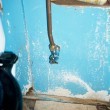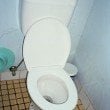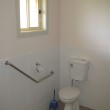B3.1 Flush toilets
Flush toilets are a simple and hygienic way to remove black water from the house.
Low water use dual flush cisterns are very efficient and can be obtained in 4.5/3 litre and 6/3 litre – full and half flush combinations. Data show there has been an increase (of 10%) in the number of houses with dual flush cisterns since 2013, now 81%.
87% of houses had toilets that were able to pass a standard flush function test. 86% of houses nationally could flush waste away, refill within 3 minutes, had functioning cisterns and pans. All these parts of the flush toilet have slightly improved since 2013.
Regular maintenance to prevent leaking cisterns will also reduce water consumption and a functioning stop valve at the cistern is essential to permit simple maintenance. Only 80% of houses had functioning cistern stop valves.
It is recommended that each house should have at least one toilet, located separately from other wet area facilities, such as shower, bath and laundry, and in a lockable cubicle. Data shows that only 72% of houses have a toilet door and lock that guarantees privacy, an improvement of 3% since 2013. But, this still needs further improvement, particularly in houses where crowding is an issue.
It is also important that a hand washing facility is provided either adjacent to the toilet or immediately outside the toilet area. Washing hands after using the toilet is important in preventing the spread of disease, particularly hepatitis.
Design and Specification
Ensure
- B3.1.1.
there is at least one flush toilet available to the house
- B3.1.2.
if the toilet is in a separate cubicle, the cubicle has a minimum depth of 1250mm in front of the toilet and 900mm clear width excluding door swings and fixtures, to allow use by people with disabilities and an adult assisting a child
- B3.1.3.
there is a hand washing facility, either a basin or tub, inside the cubicle or immediately outside
- B3.1.4.
a dual flush cistern is used and the pan is compatible with the cistern to reduce water use
- B3.1.5.
a stop valve for the toilet cistern is specified and installed to allow the cistern to be turned off for maintenance
- B3.1.6.
there is an external inspection opening for maintaining the toilet drain
- B3.1.7.
the pan is properly bedded and securely fixed to the floor and the cistern and pipes are securely fixed to the pan or wall
- B3.1.8.
there is a toilet roll holder
- B3.1.9.
the door is fitted with a privacy lock that can be unlocked from the outside in an emergency
- B3.1.10.
inward opening doors have lift-off hinges that doors are cut down to allow easy removal in an emergency
- B3.1.11.
the cubicle has natural light and ventilation and an electric light
- B3.1.12.
there is storage for spare toilet rolls and toilet brushes at a level away from the reach of young children and animals
- B3.1.13.
there is provision in the structure of the walls for grab rails
Consider
- providing a second toilet that may be accessed from outside living areas
- using a plastic cistern that is less likely to be damaged during transport to remote locations
- using a 6/3 litre, six litres for a full flush and three litres for a half flush, or approved lower (4.5/3) dual flush cistern
- providing a floor waste drain to prevent flooding in the house if the toilet overflows and to make it easier to clean the floor, using a 100mm diameter water charged floor waste drain with falls to the waste point
- fitting hand rails next to the toilet for the frail aged and people with disabilities
- fitting wall recessed toilet roll holders
- providing at least one toilet that complies fully with the local regulations for universal access, or that can be adapted in the future for use by the frail aged and people with disabilities.
- if the toilet is in a separate cubicle, increasing the clear width from 900mm to 1200mm excluding door swings and fixtures, to improve ease of use by people with disabilities
Real world examples of Solutions
- B3.1.1.
Quality control
- a dual flush toilet cistern has been provided and that the cistern and toilet pan are compatible

- COMPLETED DESIGN & SPECIFICATION
DURING CONSTRUCTION
AT HANDOVER
FINAL COMPLETION
- COMPLETED DESIGN & SPECIFICATION
- the size of the toilet area and access to the area are adequate

- SKETCH DESIGN
COMPLETED DESIGN & SPECIFICATION
AT HANDOVER
FINAL COMPLETION
TRADE TEST
- SKETCH DESIGN
- natural light and ventilation is provided to the toilet area without compromising privacy

- COMPLETED DESIGN & SPECIFICATION
DURING CONSTRUCTION
AT HANDOVER
FINAL COMPLETION
TRADE TEST
- COMPLETED DESIGN & SPECIFICATION
- a toilet cistern stop valve is installed to allow mainteance of the cistern

- COMPLETED DESIGN & SPECIFICATION
DURING CONSTRUCTION
AT HANDOVER
FINAL COMPLETION
- COMPLETED DESIGN & SPECIFICATION
- a toilet roll holder is securely attached to, or recessed into, the wall and there is high storage for spare toilet rolls

- COMPLETED DESIGN & SPECIFICATION
AT HANDOVER
FINAL COMPLETION
- COMPLETED DESIGN & SPECIFICATION
- a hand basin is provided in or nearby the toilet area

- SKETCH DESIGN
COMPLETED DESIGN & SPECIFICATION
DURING CONSTRUCTION
FINAL COMPLETION
- SKETCH DESIGN
- privacy is possible with a door and snib or privacy lock

- COMPLETED DESIGN & SPECIFICATION
AT HANDOVER
FINAL COMPLETION
TRADE TEST
- COMPLETED DESIGN & SPECIFICATION
- provision has been made in the wall structure of the toilet area for future fitting of grab rails.

- COMPLETED DESIGN & SPECIFICATION
DURING CONSTRUCTION
AT HANDOVER
- COMPLETED DESIGN & SPECIFICATION
- the toilet pan and cistern are secure and function

- AT HANDOVER
FINAL COMPLETION
- AT HANDOVER
- toilet water supply stop valve is fitted and functions

- DURING CONSTRUCTION
AT HANDOVER
FINAL COMPLETION
TRADE TEST
- DURING CONSTRUCTION
- the toilet drainage pipes are stable and drain away from the house, and have been tested before backfilling

- DURING CONSTRUCTION
TRADE TEST
- DURING CONSTRUCTION
- inspection openings and vents for the toilet comply with local regulations.

- DURING CONSTRUCTION
TRADE TEST
- DURING CONSTRUCTION
- a dual flush toilet cistern has been provided and that the cistern and toilet pan are compatible
Maintenance
As part of cyclical maintenance, check that:
- the stop valve is operating and is not 'frozen' permanently open due to build up of mineral salts

- Plumber, Local Maintenance Team
- 6 Months
- the toilet can be flushed and the cistern refills in less than three minutes

- Plumber, Local Maintenance Team
- 12 Months
- the pan does not move when pushed gently from side to side and it is not cracked

- Plumber, Local Maintenance Team
- 12 Months
- the door and privacy lock are secure and functioning

- Carpenter, Local Maintenance Team
- 6 Months
- the toilet roll holder is secure and there is a supply of toilet paper that can be stored out of the reach of children and animals

- Carpenter, Local Maintenance Team
- 6 Months
- the floor waste drain is functional

- Plumber, Local Maintenance Team
- 12 Months
- ventilation, such as a window, can be opened and closed and does not compromise privacy.

- Carpenter, Local Maintenance Team
- 12 Months
- the stop valve is operating and is not 'frozen' permanently open due to build up of mineral salts
Standard And References
AS/NZS 3500.2:2021 - Plumbing and drainage - Sanitary plumbing and drainage
AS/NZS 3500.0:2021 - Plumbing and drainage - Glossary of terms
Apunipima Cape York Health Council, Centre for Appropriate Technology Inc., Healthabitat and Pormpuraaw Community Council 1997, Pormpuraaw Housing for Health, Towards a Healthy Living Environment for Cape York Communities, project report, p. 35.
Pholeros, P, Rainow, S & Torzillo, P. 1993, Housing for Health, Towards a Healthy Living Environment for Aboriginal Australia, Healthabitat, Newport Beach, p. 45.




